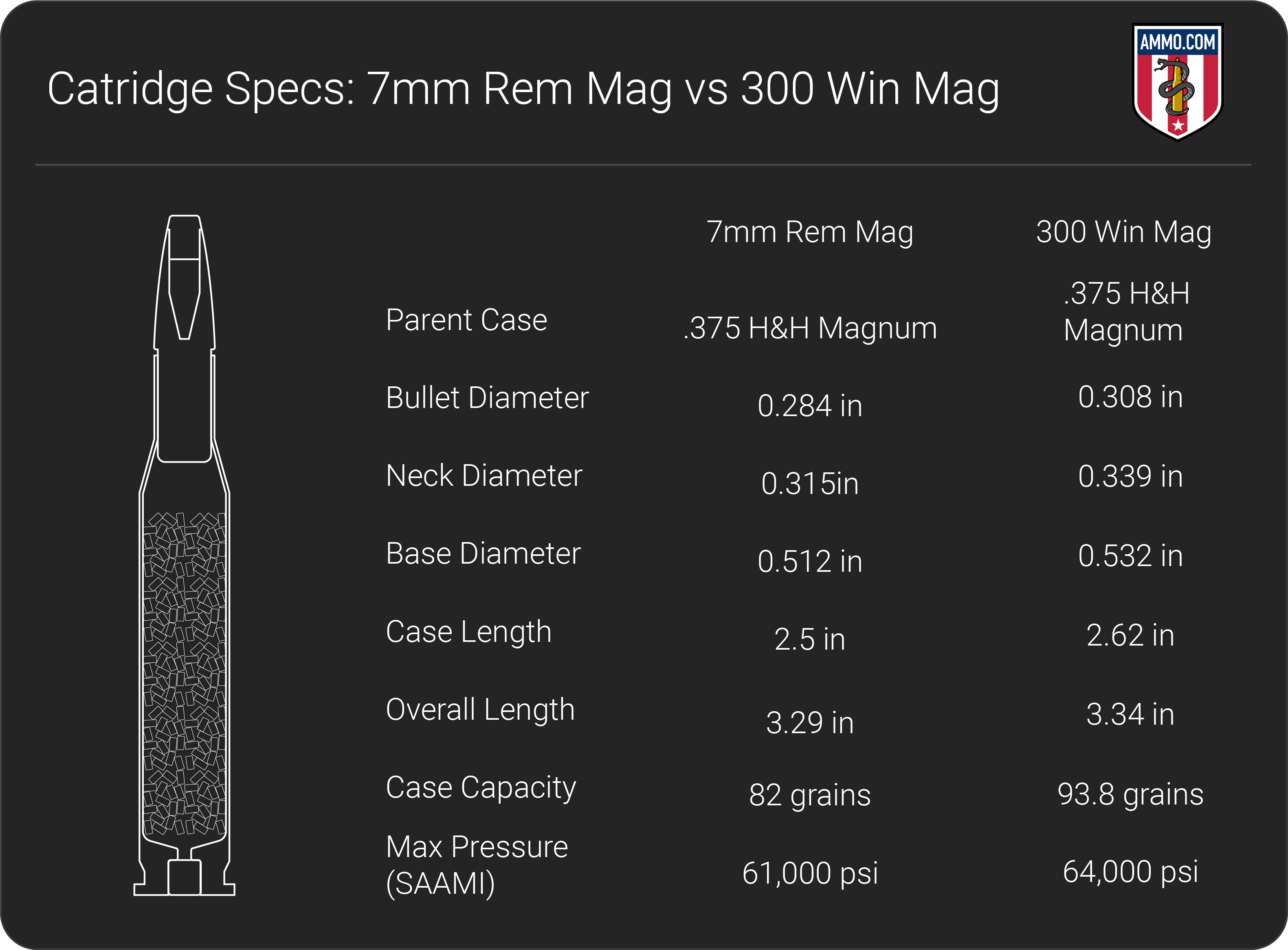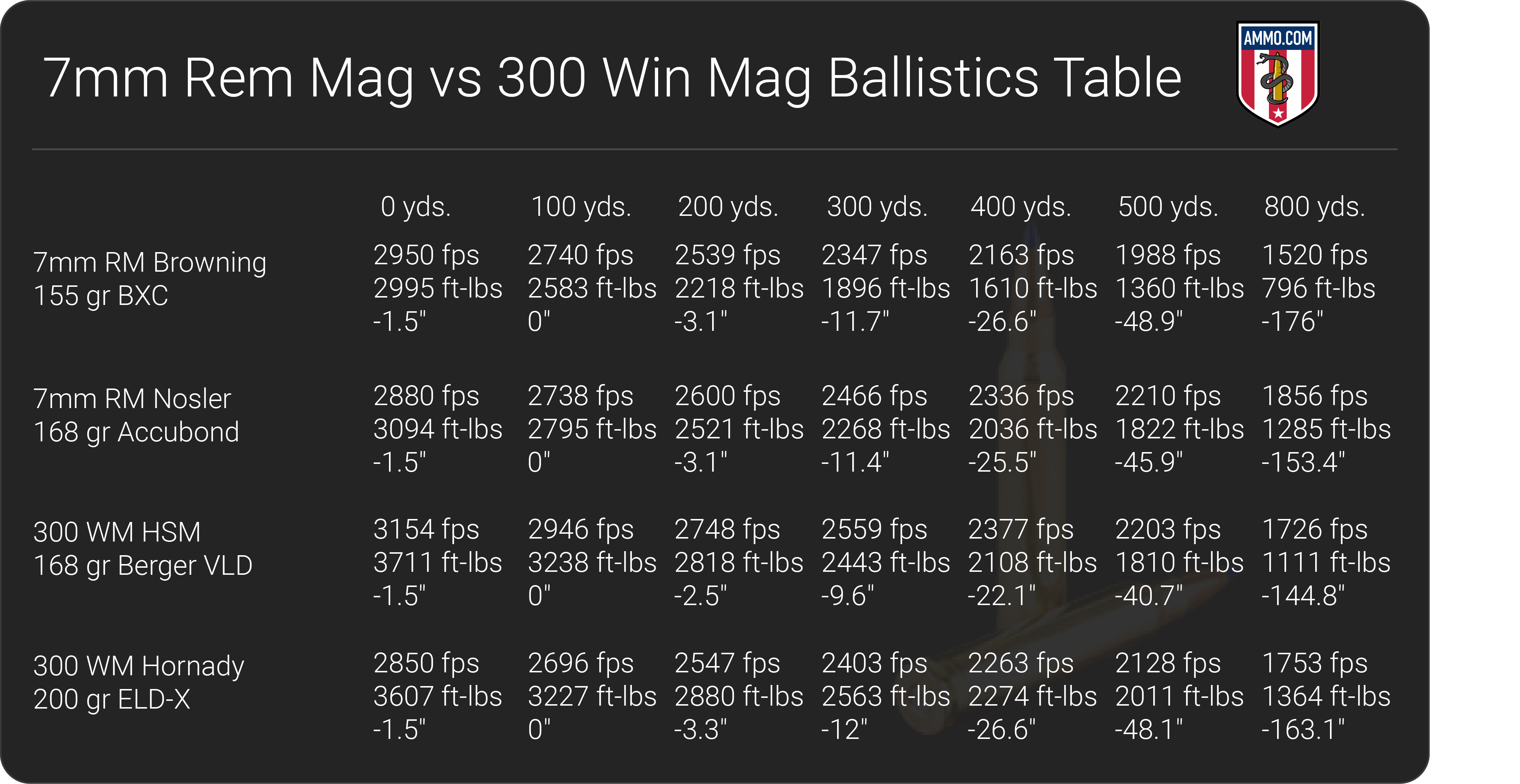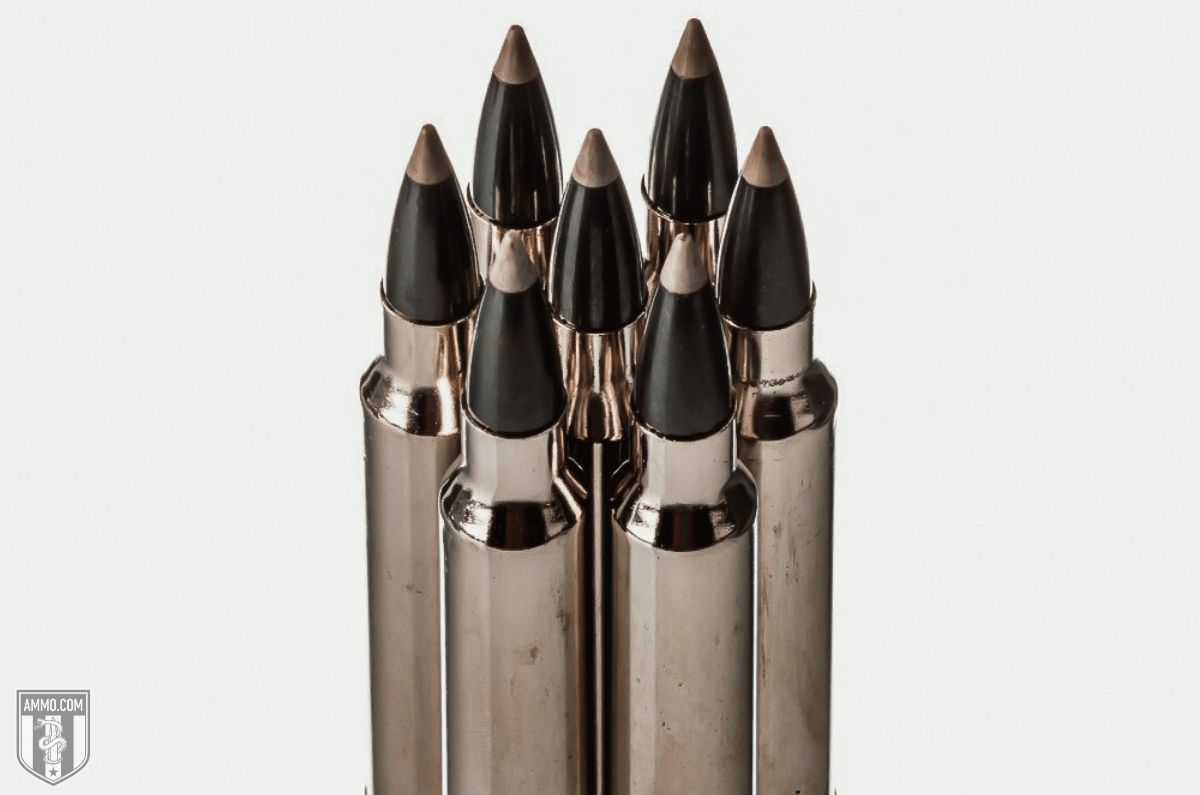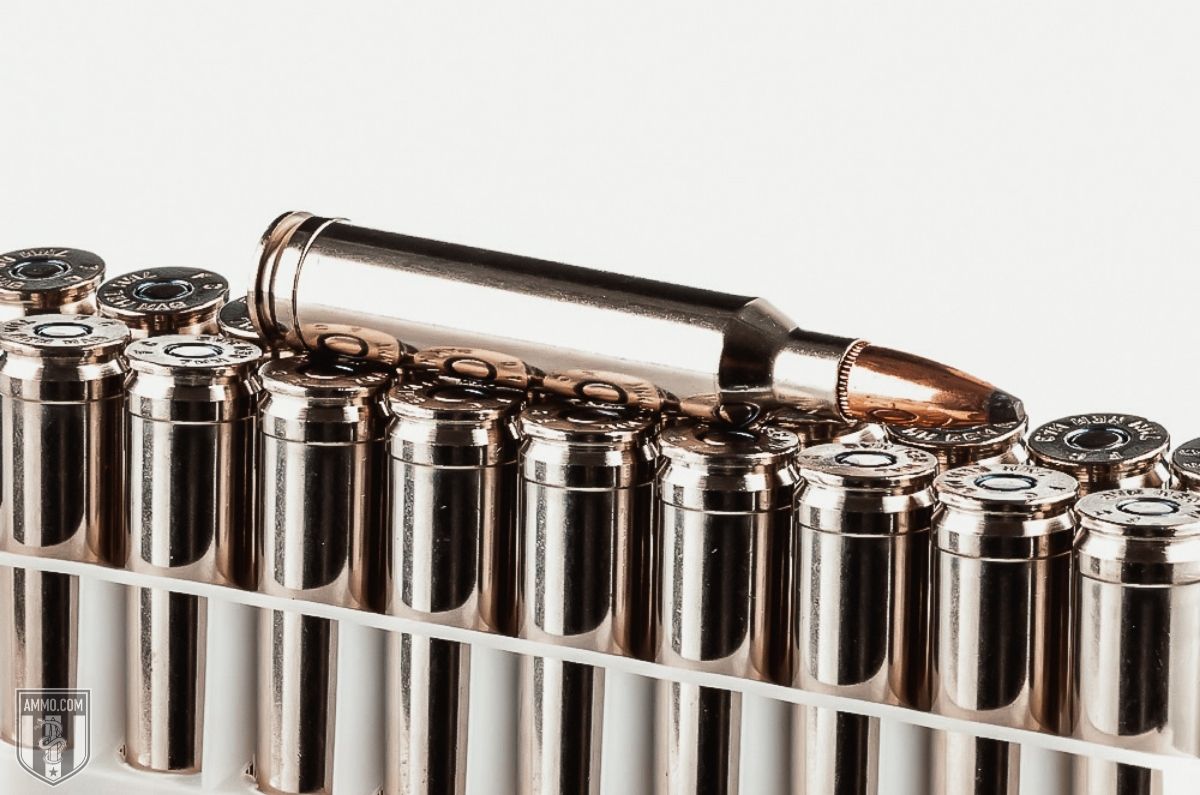7mm Rem Mag vs 300 Win Mag: Timeless Big Game Hunting Cartridges

In the world of magnum hunting cartridges, none are more ubiquitous than the 7mm Remington Magnum and 300 Winchester Magnum.
These two belted magnum cartridges have been at odds with each other since their release in the 1960’s as they both offer extremely impressive downrange performance that surpassed the most popular hunting rounds of the day, like the 30-06 Springfield.
The 300 Win Mag offers hunters higher kinetic energy and heavier bullet options while the 7mm Rem Mag provides shooters with comparable stopping power (albeit it slightly lower) with considerably less recoil.
Many hunters hem and haw about which round makes the better choice for their new rifle, as this caliber debate has been raging for well over half a century.
In this article, we will evaluate the mighty 7mm vs 300 Win Mag to help you understand the differences between the two and give you a clearer understanding of which cartridge is best for your shooting and big game hunting needs.
What is the difference between the 7mm Rem Mag and the 300 Win Mag?
The main difference between the 7mm Rem Mag and 300 Winchester Magnum is bullet diameter each cartridge fires and their recoil. The 300 Win Mag fires a 0.308” caliber bullets which are generally heavier and have higher recoil while the 7mm Rem Mag fires a 0.284” diameter bullet that is lighter and has less recoil.
Cartridge Specs
When evaluating centerfire cartridges, it’s a good idea to analyze the cartridge specs to gain more knowledge of each.
The 300 Winchester Magnum (300 WM) and 7mm Remington Magnum (7mm RM) are two rifle cartridges that have been at odds with each other since their release. It also didn’t help that they were released one year apart, as this only fueled their rivalry.

Both rounds are part of the belted magnum family of cartridges that descended from the legendary 375 H&H Magnum. The 7mm Rem Mag made it to market first in 1962 and was released alongside the company’s new bolt-action rifle, the Remington Model 700. The 7mm Magnum was touted as being a superior option to the 30-06 Springfield in every ballistic category for all bullet weights.
In contrast, the 300 Win Mag was released one year later in 1963 and was a late addition to Winchester’s belted magnum cartridge line that included the 264 Winchester Magnum, 338 Win Mag, and 458 Win Mag.
Although the 7mm Rem Mag and 300 Win Mag have the same parent case in the 375 H&H Magnum, this is where the similarities end for these two cartridges.
The first and one of the most significant differences is the bullet diameter each round fires. The 7mm Rem Mag fires a 0.284” diameter bullet while the 300 Win Mag fires a 0.308” bullet diameter.
The 300 Win Mag is typically loaded with bullet weights between 150-230 grains with the 150 gr, 165 gr, 180 gr, 200 gr, and 220 gr bullets being the most popular in factory ammo.
In contrast, the 7mm RM can fire bullets between 139 and 175 grains with the 140 gr, 150 gr, 160 gr, and 175 gr factory loads being the most popular.
When comparing these two magnum cartridges side-by-side, it’s clear that the 300 Win Mag is slightly taller than the 7mm RM. The 300 WM has a case length of 2.62” and overall length of 3.34” compared to 2.5” and 3.29” for the 7mm RM, respectively.
This overall length allows both cartridges to fit into a standard-length action. This is preferable to a magnum action, as a standard or long action is lighter and has a shorter bolt throw for faster follow-up shots.
The longer case length as well as shoulders that sit 0.156” further forward gives the 300 Win Mag approximately a 14% advantage in case capacity. The case capacity of the 7mm Rem Mag is 82 grains while the 300 WM can hold 93.8 grains of propellant.
As the 300 Win Mag can be loaded slightly hotter, it also is rated to handle more chamber pressure than the 7mm RM. Per SAAMI specs, the 300 Win Mag can safely handle 64,000 psi while the 7mm Rem Mag is rated slightly lower at 61,000 psi.
With all that extra case capacity, heavier projectiles, and higher pressures, it should come as no surprise that the 300 Win Mag has higher recoil. How much is the big question.
Recoil
Recoil is an important consideration when purchasing a new rifle as a round with heavy recoil will be more difficult to control and will slow your rate of follow up shots. The potential for flinching is also an issue for cartridges with heavy recoil.
Felt recoil will differ from shooter to shooter and is often dependent on firearm choice, stance, and your chosen factory ammo or handloads. However, free recoil is a more objective measure of how hard a cartridge hits based on firearm weight, muzzle velocity, powder charge, and bullet weight.
For the purpose of this recoil comparison, we selected two rounds that are excellent for long range shooting as well as harvesting a variety of game animals. The rounds selected were the Nosler 168 gr Accubond Long Range traveling at 2,880 fps for 7mm Rem Mag and the Hornady 200 gr ELD-X traveling at 2,850 fps for 300 WM.
The rifle for this comparison will be the Remington 700 SPS Stainless bolt-action rifle weighing 7.6 lbs. This rifle was chosen as it can fire both cartridges and provides a closer apples-to-apples recoil comparison.
Given this rifle and these two rounds, the 7mm Remington Magnum will have a free recoil measurement of 29 ft-lbs compared to 39 ft-lbs for the 300 Win Mag.
This is one of the main selling points that supporters of the 7mm Rem Mag often cling to, that the 7mm Magnum has about 25% less recoil than the 300 Win Mag.
Muzzle Velocity, Kinetic Energy, and Trajectory
The 300 Win Mag may have more recoil than the 7mm RM, but the 300 also has several ballistic advantages over the 7mm Magnum that can’t be ignored.
To analyze the ballistic performance of both magnum cartridges, four popular big game hunting rounds were selected for comparison.
For the 300 Winchester Magnum, the Hornady Precision Hunter 200 gr ELD-X and HSM Trophy Gold Ammunition firing a 168 gr Berger Hunting VLD bullet were selected. For 7mm Remington Magnum, the Browning 155 gr BXC and Nosler Trophy Grade 168 gr Accubond Long Range were our rounds of choice.
The 168 grain bullets were selected to illustrate performance differences in both cartridges for projectiles of similar bullet weight while the 155 gr and 200 gr bullets were selected to show performance on the high and low bullet weight spectrum for both rounds.

In terms of muzzle velocity, the 300 Win Mag projectiles will generally have higher velocity for similar bullet weights. This is clearly illustrated with the two 168 gr factory loads, as the 300 WM had nearly 300 fps more than the 7mm RM offering. The 168 gr VLD fired by the 300 Win Mag had the highest muzzle velocity at 3,154 fps.
The 200 gr ELD-X had a muzzle velocity of 2,850 fps, which is impressive as the 155 gr BXC was only 100 fps faster while being nearly 25% lighter.
For kinetic energy, the 300 Win Mag continues its dominance and earns its reputation as a heavy hitter. On average, the 300 WM factory loads had 3,650 ft-lbs of kinetic energy at the muzzle. Comparatively, the 7mm Rem Mag loads had on average around 3,000 ft-lbs of energy.
Both the 7mm and 300 WM are incredibly flat shooting and well-suited for long range shooting.
In terms of trajectory, all four rounds had nearly identical bullet drop out to 500 yards. However, at 800 yards we start to see some variations between the four factory loads.
At longer ranges, the 300 WM 168 gr VLD had the flattest trajectory with -144” of bullet drop while the 7mm RM 155 gr BXC had the most bullet drop at -176”. Of the two 168 grain loads, the 300 WM had the flatter trajectory while the 7mm Rem Mag Accubond had more bullet drop, measuring -153”.
Ballistic Coefficient and Sectional Density
Ballistic coefficient (BC) is a measure of how aerodynamic a bullet is and how well it will resist wind drift. Sectional density (SD) is a way to evaluate the penetration ability of a bullet based on its external dimensions, design, and weight.
In general, both bullets will have relatively similar ballistic coefficients. The 7mm bullet benefits from its slender and sleek design while the 308 bullet benefits from its heavier bullet weight.
From the bullets selected earlier, the 7mm RM 168 gr Accubond Long Range had the highest BC of 0.652 while the Hornady 200 gr ELD-X for 300 WM had a BC of 0.597. If we only consider these two bullets, it would be easy to say that the 7mm Rem Mag has higher BC values. However, on average the 300 Win Mag will have a slightly higher BC than the 7mm Rem Mag, but the difference is so low that most shooters will not notice any variation in ballistic performance between the two rounds.
The same is true for sectional density, on average the 300 Win Mag has slightly higher SD values than the 7mm Rem Mag.
Typically, smaller diameter bullets will have improved penetration ability, as more kinetic energy can be focused in a smaller area. However, as the 300 Win Mag is packing more kinetic energy, it will have a very minor SD advantage over the 7mm RM.
Will this affect terminal performance of the 7mm Rem Mag on big game? Not in the slightest, as I doubt the elk or mule deer on the business end of your hunting rifle will be able to tell much difference between either of these magnum cartridges.
Hunting
There is little debate that the 300 WM and 7mm RM are great cartridges for any sized four-legged varmint the North American continent has to offer. They are both hard hitting cartridges that can take down moose, elk, mule deer, whitetail, hogs, and anything else in between.
With proper shot placement, even the great bears can be harvested humanely.
However, the debate rages on between big game hunters about which cartridge is the better hunting round. It’s unlikely that we will resolve this debate anytime soon, however you can take solace that both magnum cartridges will get the job done so long as you do your part.
The 300 Win Mag has an advantage in kinetic energy and bullet weight. The 300 WM can fire bullets up to 220 grains while the 7mm Rem Mag tops out around 175 grains. Some hunters prefer heavier bullets of the 300 WM, with 180 grain bullets being extremely popular for both deer and elk hunting.
The 300 Win Mag also fires a wider bullet, which will leave a bigger hole. This aids in reducing suffering of the animal by increases the rate of blood loss.
For a comprehensive list, check out our recommendations for the best 300 Win Mag ammo for deer hunting!
On the other hand, the 7mm Rem Mag has significantly less recoil than the 300 Win Mag while only sacrificing a few hundred foot-pounds of kinetic energy. Low recoil makes for better trigger control and higher levels of accuracy for long range shooting.
Expanding hunting bullets like the Nosler Accubond, Barnes TSX, and Berger Hunting VLD also mitigate the minor differences in bullet diameter.
This makes bullet selection slightly more important for the 7mm Rem Mag, but with the right factory load it is unlikely that any hunter can detect the minor differences in terminal ballistics between a deer shot with a 300 Win Mag or 7mm Rem Mag.
There are clearly benefits to each cartridge, so which one is the better choice?
In truth, the best hunting cartridge is the one that delivers enough kinetic energy to ethically harvest your targeted game animal and one that you shoot the most accurately.
Some shooters like the safety net of kinetic energy the 300 Win Mag provides, as it ensures a clean kill so long as they put their shot in the vitals. However, other hunters find they are more accurate with the 7mm Remington Magnum and they prefer the comfort of knowing their shot placement will be on point so long as they don’t get buck fever.
The best advice we have is to try both, see which rifle cartridge you shoot most accurately. Get plenty of practice before hunting season and you should have nothing to worry about, because no game animal on North America will survive a double-lung broadside shot from either.
Ammo and Rifle Cost/Availability
The 300 Winchester Magnum and 7mm Rem Mag consistently live in the top 5 most popular big game hunting cartridges on the market. However, the 300 Win Mag is slightly more popular thanks to its adoption as a sniper round for the U.S. military as well as many law enforcement agencies.
Ammunition manufacturers like Hornady, Remington, Federal, Winchester, Barnes, Nosler, Berger, and Sierra all make multiple factory loads with a variety of projectile weights for both cartridges.
In terms of price, both rounds are virtually the same. Inexpensive soft point practice ammo from Sellier & Bellot can be had for around $1.85/round for both 300 WM and 7mm RM. On the other hand, long range match-grade ammo or premium hunting rounds can fetch upwards of $3-5/round for each.
When it comes to firearm selection, bolt-action rifles are the name of the game as both cartridges are built for long range precision shooting.
All major rifle manufactures have rifles available in both calibers. Popular hunting rifles like the Tikka T3x, Savage 110, Remington 700, Ruger Hawkeye, and Weatherby Vanguard are all available chambered in both cartridges in multiple configurations.
If you fancy a semi-automatic hunting rifle, then the Browning BAR is also available in both chamberings as well as custom AR-10 rifles from Noreen and Nemo Arms.
Due to its military and law enforcement use, there will be slightly more rifles available chambered in 300 Win Mag. There are more than enough 7mm Rem Mag options out there for even the most discerning shooter, but the 300 Win Mag is slightly more popular and will have a marginal advantage in terms of availability.
Reloading
Reloading is one method shooters use to reduce their overall cost per round and increase the consistency and accuracy of their ammo to sub-MOA levels. Furthermore, handloads can be tailored to your rifle to meet your specific shooting needs.
Handloaders have been reloading for both cartridges since their release in the 60s, as such there is a wealth of reloading data available for virtually any bullet profile.
In terms of bullet availability, 30-caliber bullets are one of the most popular in North America as it is also fired by the 308 Winchester, 30-06 Springfield, 300 WSM, and 300 Blackout. The 30-cal is nothing short of an American shooting tradition, so finding bullets for reloading will be relatively simple.
The 7mm bullet is not as popular as the 30-caliber, but there are still plenty of high-quality match and hunting projectiles available for it. Some popular cartridges that fire 0.284” bullet diameters are the 28 Nosler, 280 Remington, 7mm Weatherby Magnum, and 7mm-08.
Both cartridges utilize similar powders depending on the weight of the reloaded bullet. Lightweight bullets can use popular powders like Varget, IMR 4895, and H4831, while heavier bullets will utilize powders like Retumbo or H1000.
Regardless of what bullet weight you want to fire, there will be plenty of reloading options for your specific shooting requirements.
Final Shots: 300 Win Mag vs 7mm Rem Mag
If you’re looking for a magnum cartridge that can deliver exceptional downrange performance and has a storied pedigree of taking down big game, then look no further than the 300 Winchester Magnum and 7mm Remington Magnum.
Both rounds deliver the kinetic energy needed to take down the largest animals North America has to offer and are incredibly flat shooting to boot.
The 300 Winchester Magnum has been a favorite of big game hunters since its release and is the most popular belted magnum cartridge on the market. The round has proven itself to be an excellent choice for long range shooting and has been adopted by the Secret Service as well as military and law enforcement snipers, which has only increased its popularity in the shooting community.
The 7mm Remington Magnum was developed to offer shooters a straight upgrade over the venerable 30-06 Springfield. The 7mm is a heavy hitting cartridge that fires efficient, high ballistic coefficient bullets with less recoil than the 300 Win Mag.
Deciding between these two cartridges is nothing short of splitting hairs, but our choice is the 300 Win Mag due to its popularity, ammo availability, and cool-factor of knowing you’re locked and loaded with the same cartridge that’s perched atop 1600 Pennsylvania Avenue.
That being said, for those shooters who want a more enjoyable shooting experience or are recoil sensitive, you cannot argue with 7mm Rem Mag ballistics in addition to having 25% less recoil than the 300 Win Mag.
No matter which cartridge you choose, make sure you stock up on ammunition here at Ammo.com and I’ll see you on the range!
Ammo Comparisons
- .308 vs 5.56
- 6.5 Creedmoor vs .308
- .300 Blackout vs .308
- .300 Win Mag vs .308
- .243 vs .308
- .308 vs .30-06
- 7mm-08 vs .308
- .270 vs .308
- 7.62x39 vs .308
- .223 vs .308
- .338 Lapua vs .308
- .380 ACP vs 9mm
- .223 vs 5.56
- .300 Blackout vs 5.56
- 9mm vs 45 ACP
- 9mm vs 40 S&W
- .357 SIG vs 9mm
- 10mm vs 9mm
- 9mm vs 9mm Luger
- .243 vs .270
- .300 Win Mag vs .30-06
- .270 vs .30-06
- .40 vs .45
- 38 Special vs 357
- 9mm vs 40 vs 45
- 5.56 vs 7.62x39
- 338 Lapua vs .30-06
- .30-30 vs .30-06
- 300 PRC vs 338 Lapua
- .30-06 vs 7mm
- 300 Win Mag vs 338 Lapua
- 300 PRC vs 300 Win Mag
- 300 WSM vs 300 Win Mag
- 338 Win Mag vs 338 Lapua
- 12 Gauge vs 20 Gauge
- 10mm vs 357 Mag
- .30-30 vs 7.62x39
- 224 Valkyrie vs 22-250
- 17 HMR vs 22 Mag
- 7.62x39 vs .300 Blackout
- 45 ACP vs 45 Auto
- 45-70 vs 30-30
- 300 Blackout vs 223
- 357 Magnum vs 9mm
- 350 Legend vs 300 Blackout
- 224 Valkyrie vs 223
- 45 ACP vs 38 Super
- 6.5 Grendel vs .308
- 17 HMR vs 22 LR
- 10 Gauge vs 12 Gauge
- 22-250 vs 223
- 45 Colt vs 45 ACP
- 350 Legend vs 30-30
- 5.7x28 vs 223
- 5.7 vs 9mm
- 5.56 vs 5.7
- 22 vs 9mm
- Buckshot vs Birdshot
- 450 Bushmaster vs 308
- 450 Bushmaster vs 223
- Buckshot vs Slug
- 6.5 Grendel vs 5.56 vs 223
- 6mm ARC vs 6.5 Grendel
- 44 vs 45
- 458 SOCOM vs 5.56
- 357 vs 44
- 32 ACP vs 380
- 300 Win Mag vs 338 Win Mag vs 338 Lapua Mag
- 450 Bushmaster vs 458 SOCOM vs 50 Beowulf
- 6mm Creedmoor vs 6.5 Creedmoor
- TMJ vs FMJ
- 44 Special Vs 44 Magnum
- 45 90 vs 45 70
- 6.8 Western vs 6.8 SPC
- 50 Beowulf vs 50 BMG
- 26 Nosler vs 6.5 PRC
- 28 Gauge vs 410
- 6.8 SPC vs 5.56
- 6.8 SPC vs 6.5 Grendel
- 6.8 Western vs 7mm Rem Mag vs .28 Nosler
- 6.8 Western vs 6.5 Creedmoor
- 22 Hornet vs 223
- 6.8 Western vs 6.5 PRC
- .410 vs 12 Gauge
- .410 vs 20 Gauge
- 22 LR vs 22 Mag
- 6mm ARC vs 243
- 7mm-08 vs 270
- 243 vs 6.5 Creedmoor
- Nickel vs Brass Casing
- 204 Ruger vs 223
- 50 Beowulf vs 5.56
- 260 Remington vs 6.5 Creedmoor
- 6mm Remington vs 243
- 28 Nosler vs 300 PRC
- 50 Beowulf vs 50 AE
- 22 Nosler vs 22-250
- 450 Marlin vs 45-70
- 300 Win Mag vs 300 Norma
- 458 SOCOM vs 300 Blackout
- 38-55 vs 45-70
- 22 Hornet vs 22 LR
- 300 Norma vs 338 Lapua
- 338 Lapua vs 50 BMG
- 28 Nosler vs 300 Win Mag
- 28 Nosler vs 6.5 Creedmoor
- 204 vs 22-250
- 458 SOCOM vs 45 70
- 44 40 vs 45 70
- 6.8 SPC vs 6.5 Creedmoor
- 450 Bushmaster vs 30-06
- 7mm Rem Mag vs 300 Win Mag
- 30 Carbine vs 223
- 25-06 vs 30-06
- 26 Nosler vs 28 Nosler
- 16ga vs 12ga
- 30 06 vs 7.62 x54R
- 9mm Makarov vs 9mm Luger
- 350 Legend vs 223
- 30 Carbine vs 5.56
- 6.5x55 vs 6.5 Creedmoor
- 6.5 Creedmoor vs 270 vs 25-06
- M193 vs M855
- 450 Bushmaster vs 458 SOCOM
- 6.5 Grendel vs 6.5 Creedmoor
- 350 Legend vs 5.56
- .277 Fury vs 6.8 SPC
- 277 Fury vs 300 Win Mag
- 10mm vs .45 ACP
- 277 Fury vs 223
- 6.8 SPC vs 300 Blackout
- 6.5 PRC vs 6.5 Creedmoor
- 277 Fury vs 308
- 277 Fury vs 6.5 Creedmoor
- 350 Legend vs 450 Bushmaster
- 277 Fury Vs 5.56 NATO
- 10mm vs 40S&W
- 32 ACP vs 9mm
- 32 Special vs 9mm
- 8.6 Blackout vs 300 Blackout
- 30 Super Carry vs. 9mm
- 5.56 vs 9mm
- .50 Action Express vs 9mm
- 7.62x25 vs. 9mm
- 10mm vs 44 Magnum
- 300 Blackout vs 300 Win Mag
- 6.5 Grendel vs 300 Blackout
- 460 Rowland vs 10mm
- 300 RUM vs 300 PRC
- 300 Norma vs 300 PRC
- 45 GAP vs 45 ACP
- 7mm PRC vs 300 Win Mag
- 300 PRC vs 6.5 Creedmoor
- 300 PRC vs 308
- 357 SIG vs 357 Mag
- 7.62x39 vs 7.62x51
- 243 Win vs 223 Rem
- 30 Nosler vs 300 PRC
- 6.5 Creedmoor vs. 30-06 Springfield
- 450 S&W vs. 44 Magnum
- 6.5 Creedmoor vs. 300 Win Mag
- 454 Cassull vs. 45-70 Govt
- 454 Cassull vs. 44 Mag
- 7.62x54r vs. 308 Winchester
- 22 ARC vs. 223 Rem
- Subsonic vs. Supersonic Ammo








